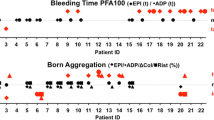Abstract
Objective
To preliminarily explore the relationship between thrombosis and its associated factors in patients with coronary heart disease (CHD) of turbidity-phlegm blocking syndrome (TPB), and to study its acting mechanism.
Methods
Plasma levels of thrombosis-associated factors, including Von Willebrand factor: (vWF), D-dimer, and fibrinogen (Fg), in 85 patients of CHD with TPB, 93 with CHD of non-TPD, and 89 healthy persons were detected and compared.
Results
Levels of the three factors were increased in all the CHD: patients, and were higher in TPB patients than in non-TPB patients (P<0.01 or P<0.05).
Conclusion
The TPB: syndrome in CHD patients was closely related to the blood coagulation-fibrinolytic system; they might be in pre-thrombosis state, and the plasma levels of vWF, D-dimer, and Fg could be taken as the objective indices for thrombosis differentiation of TPB syndrome in CHD patients.
Similar content being viewed by others
References
Wang ZY, Li JZ, Ruan CG, Song JJ, Wang HL, Han ZC eds. Thrombosis and hemostasis: basic principles and clinical practice. 4th ed. Shanghai: Shanghai Scientific and Technical Publishers; 2004:529–531.
Chinese Society of Cardiovascular Diseases, Chinese Medical Association. Guidance for diagnosis and treatment of chronic stable angina pectonis. Chin J Cardiol (Chin) 2007;35:195–200.
Chinese Society of Cardiovascular Diseases. Guidance for diagnosis and treatment of unstable angina and non-ST elevated myocardial infarction. Chin J Cardiol (Chin) 2007; 36:1–6.
Zheng XY, ed. Guiding principle of clinical research on new drugs of Chinese medicine. Beijng: China Press of Traditional Chinese Medicine; 2002:68–73.
Zhao MF, An DQ. Preliminary investigation on syndromes of dirty phlegm stagnation of chest stuffiness in Xinjiang as well as its prevention and treatment. Xinjiang J Tradit Chin Med (Chin) 2008; 26:84–85.
Morange PE, Simon C, Alessi MC, Luc G, Arveiler D, Ferrieres J, et al. Endothelial cell markers and the risk of coronary heart disease: the Prospective Epidemiological Study of Myocardial Infarction (PRIME) Study. Circulation 2004;109:1343–1348.
Wang R, Hu DN. Significance of D-dimer and fibrinogen in patients with different kinds of coronary heart disease.Chin Med Herald (Chin) 2006; 35:157–158.
Zheng YS, Zheng QP, Duan LF, Zhang LP. Relationships between plasma D-dimer and coronary heart disease. J Clin Cardiol (Chin) 2004; 20:83–85.
An DQ, Zhao MF, Zheng J, Hu JX. Discussion on chest fullness of phlegm-turbidity stagnation syndrome in Xinjiang. Xinjiang J Tradit Chin Med (Chin) 2007; 2:1–2.
Author information
Authors and Affiliations
Corresponding author
Rights and permissions
About this article
Cite this article
Wang, Yl., An, Dq., Ma, N. et al. Study on the changes of thrombosis-associated factors in patients with coronary heart disease of turbidity-phlegm blocking syndrome. Chin. J. Integr. Med. 15, 337–340 (2009). https://doi.org/10.1007/s11655-009-0337-z
Received:
Published:
Issue Date:
DOI: https://doi.org/10.1007/s11655-009-0337-z




